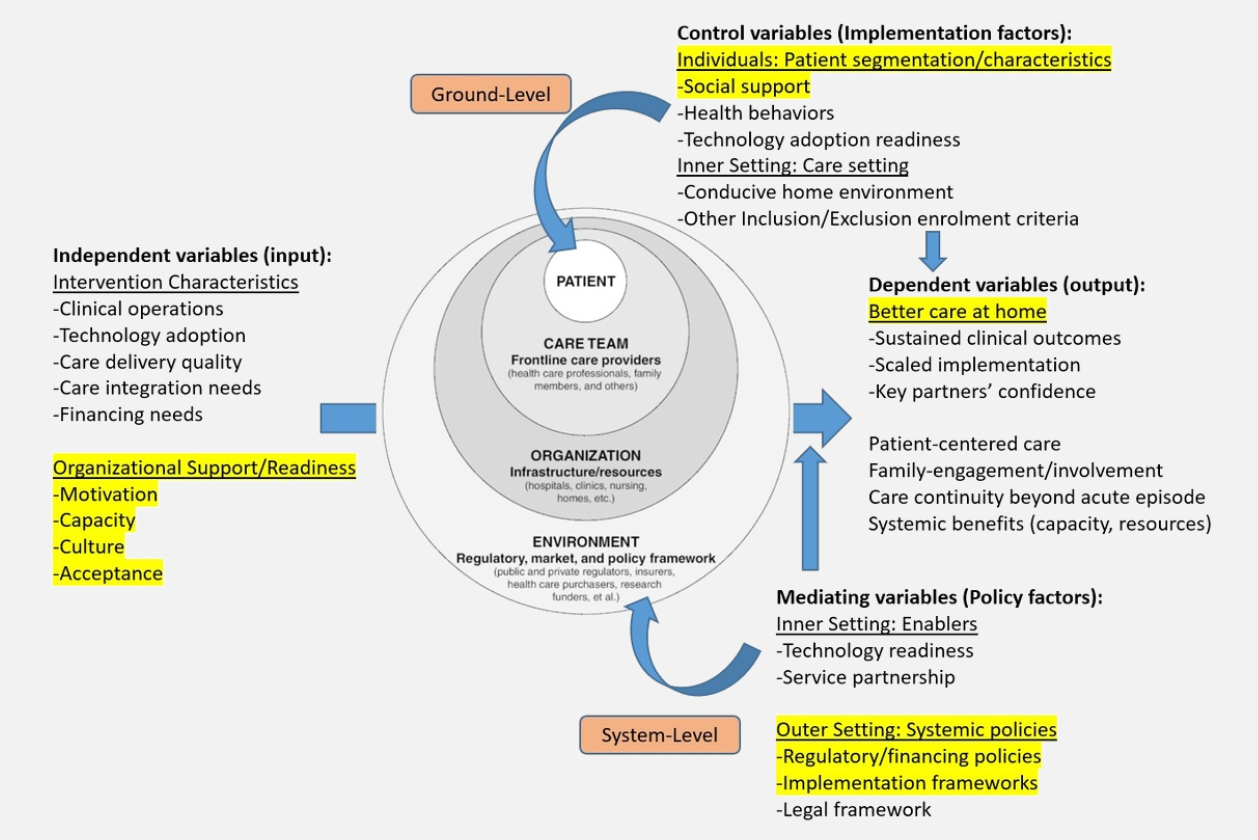|
The COVID-19 pandemic has disrupted the traditional healthcare system globally by overwhelming hospital bed capacity and scarce resources.
This huge resource strain threatens the safety and quality of healthcare delivery (Sitammagari et al., 2021) in Singapore and beyond.
In this qualitative study, we have engaged key implementation stakeholders such as healthcare professionals and staff members of the COVID-19 virtual wards and Sandbox Model, private healthcare providers and policy makers in advancing the following objectives:
1. Understanding of the need for an alternative mode of care delivery such as virtual care.
2. Attitudes towards the viability of virtual hospitals or bed care models to augment acute beds’ supply or demand in future pandemics.
3. Gaps and opportunities for interventions and innovations to the existing virtual ward programmes implemented for COVID-19.
Semi-structured interviews were conducted among healthcare professionals from restructured hospitals and government officials in Singapore.
The interview guide was curated with referenced key constructs from the Consolidated Framework for Implementation Research. The interviews were transcribed verbatim, coded, and analyzed by thematic analysis.
In turn, the study findings can help inform steps in co-creating and improving interventions – e.g. healthcare delivery to home and scalable technology-enabled platforms for teleconsultations and monitoring – to reduce reliance on limited hospital resources, more effectively respond to pandemics in the future and ensure sustainability in our healthcare system.
|
| |
|
In the WHAHC 2023, our study’s major themes and various sub-themes were presented. Findings highlighted that optimal patient selection (strict inclusion-exclusion criteria including severity and complexity of clinical conditions and the accessibility to a conducive home environment with essential social support) was key to virtual wards' success. Participants reported perceived better care at home- lower hospital admissions, mortality rates and greater ability to channel limited resources to patients with high deterioration risk. Patients are also able to enjoy non-inferior personalized quality care in the comforts of their own homes.
Participants also explored new opportunities for further sustainability and scalability including,
- Optimizing and establishing patient eligibility criteria.
- Improve the design of workflows and processes.
- Early development and establishment of policies.
- Stakeholder engagement.
- Effective communication.
- Skilled workforce to implement person-centered virtual hospital-at-home.
- Acceptance by staff.
|
| |

Click here to view the whole poster
|
| |
|
Our study highlighted a need for an alternative to brick-and-mortar hospitalization. Many believe in the viability of upscaling virtual hospitals to be part of the standard practice of care while ensuring the safety and effectiveness of this care model. The hospitals' leadership and decision makers were also very supportive of the initiative alongside many of the participants who were very passionate and enthusiastic about being part of this model of care despite being the trailblazers and having little to no pre-established frameworks.
Our study also affirmed previous local studies which looked at attitudes and perceptions among the patients and their caregivers (Lai et al., 2021). While there is much room for improvement on the implementation-related gaps and opportunities for interventions and innovations to these existing unsubsidized homecare programmes, the majority of the participants believe that Singapore is ready for such a care plan. To better prepare for future pandemics, Singapore’s aging population, and increasingly limited hospital resource capacity in Singapore, it is crucial for virtual wards to be part of the standard of care in our healthcare system and extend to a wider range of diseases.
|
| |
ABOUT THE AUTHOR
|
| |

Ms. Pua Si
Ning Jannah
A final-year
Pharmacy
undergraduate at the National University of Singapore (NUS), Jannah is passionate about the delivery of patient-centered care
in the community setting. She is deeply interested in the study of population
health and believes in the use of primary prevention care methods to alleviate
the burden on healthcare systems.
|
| |
|
Co-authors: Ms. Sim Mei Ying Tomiko, Mr. Tan Chun
Shing Jerald, and Mr. Yi Feng Lai. References:
- Lai, Y. F., Lim, Y. W., Kuan, W. S., Goh, J., Soong, J. T. Y., Shorey, S., & Ko, S. Q. (2021). Asian attitudes and perceptions toward hospital-at-home: A cross-sectional study. Frontiers in Public Health, 9. https://www.frontiersin.org/articles/10.3389/fpubh.2021.704465
- Sitammagari, K., Murphy, S., Kowalkowski, M., Chou, S.-H., Sullivan, M., Taylor, S., Kearns, J., Batchelor, T., Rivet, C., Hole, C., Hinson, T., McCreary, P., Brown, R., Dunn, T., Neuwirth, Z., & McWilliams, A. (2021). Insights from rapid deployment of a “virtual hospital” as standard care during the covid-19 pandemic. Annals of Internal Medicine, 174(2), 192–199. https://doi.org/10.7326/M20-4076
|
| |
|